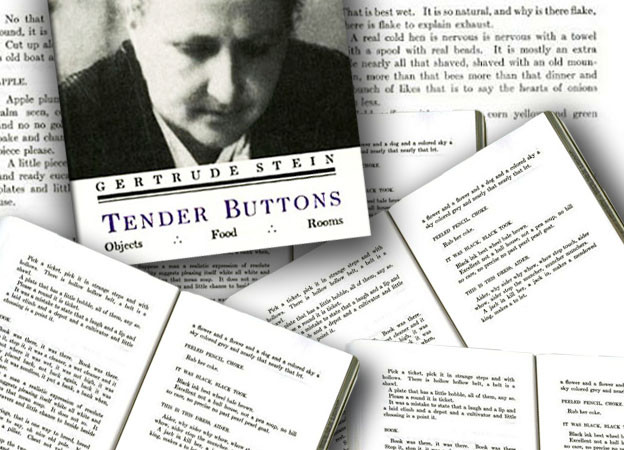'100 years of reading and unreading'

The dominant stylistic trait in Tender Buttons is not fragmentation or perspectivism but looping. Stein writes by looping similar or associative words, phrases, riffs, objects, units of meaning, or sonic hooks. She calls it “exact resemblance.” She also loops sense with nonsense, doing and undoing, continuity and discontinuity, sensual interiors with external surrounds, looping the environs into the work. Actually, any kind of binaries can be entwined, just as two identical terms can be spooled. Here is a sentence from “Rooms”:
Sugar any sugar, anger every anger, lover sermon lover, center no distractor, all order is in a measure[1]
Stein’s recursive riffs become their own act of description describing itself in the act. She is writing through her own writing. Or one could say that looping is itself partly doing the writing.
A no, a no since, a no since when, a no since when since, a no since when since a no since when since, a no since, a no since when since, a no since, a no, a no since a no since, a no since, a no since (344)
Innocence threaded through a nuisance. The famous phrase “The difference is spreading” perhaps refers to the minimal difference between looped terms. The spread: the difference between terms and their relations.
But why loops? If you asked this question for today, here are some immediate responses: computers, programming, cognitive modeling, financialization, new media, ecologies, carbon cycles, weather, DNA, galaxies, quantum mechanics. So why loops in Stein’s era? Perhaps: personhood, meditation, grammar, mechanism, neurology, automism, joy, history, sensuality, sex, objecthood, nature, female masculinity.
A great example of the combination of these “beautiful circuits” (Mark Goble’s term) can be found in Jackson Mac Low’s “Stein Poems,” written from 1998 to 2003. Mac Low used a computer program to generate a “diastic” poem that was made by running an algorithm through a cross between a source text and seed text. In “Mercy Entirely Astonishing,” the seed and source text comes from “Objects” in Tender Buttons.
Mercy, giving color, hardening interest, changes mustard dangerously.
Use an empty umbrella.
Desperately, the handy extra particles are practically complaining that facts are stubborn.
A purse is a purse and nothing is nothing.[2]
We are reading a text-generated reading of Tender Buttons made by subjecting Tender Buttons to itself. Reading means no need to draw the line between poem and post-poem, seed and re-seed, Stein’s “Mildred’s Umbrella” and Mac Low’s “empty umbrella.”
One more thing: Stein’s loops are never really faithful to recursion and they often swerve, break apart, spin out, or leap somewhere else. There is no superloop. There is much of an aftermath of loops, reverberations of reverb (a nice term for a self-reflexive verb looping within itself). One hundred years of loops. One hundred years of reading and unreading. One hundred years of read-back and read-forward. 100 years of not unreading, not unordered in not resembling.
1. Gertrude Stein, Writings: 1903–1932 (New York: Library of America, 1998), 353.
2. Jackson Mac Low, Thing of Beauty: New and Selected Works, ed. Anne Tardos (Berkeley: University of California Press, 2008), 406.